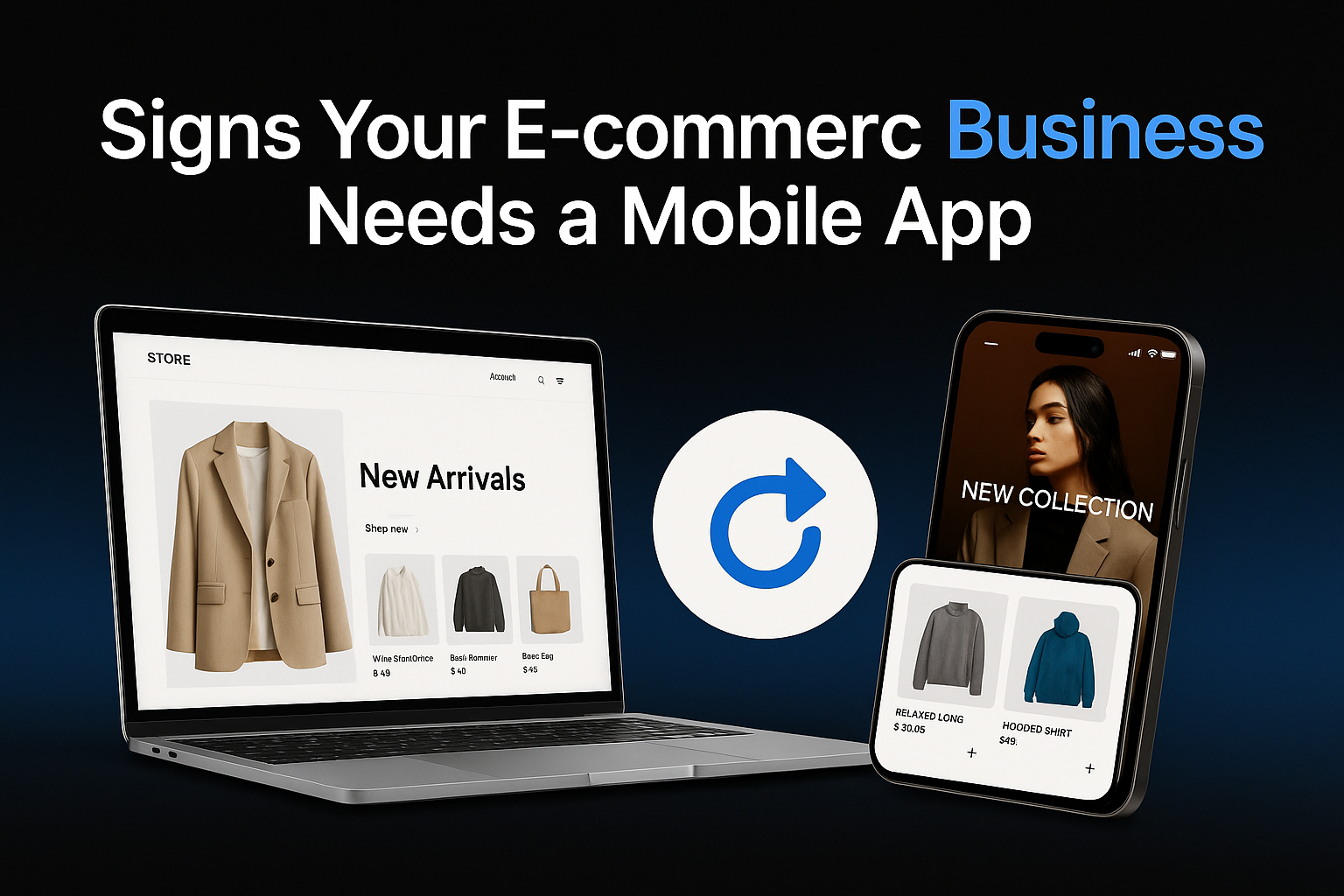7 Critical Signals Your E-commerce Business Should Transition to a Mobile App
Research consistently shows that mobile apps outperform mobile websites in virtually every key performance metric. According to our data, a significant majority of customers prefer native app experiences over mobile browsers—a preference that directly impacts conversion rates, order values, and customer loyalty.

7 Signals Your E-commerce Store Needs a Mobile App
1. Your Mobile Website Conversion Rate Plateaus Below Expectations
If your mobile website conversion rate has stalled despite optimization efforts, a dedicated app may be the breakthrough you need. Mobile apps achieve conversion rates significantly higher than mobile sites, primarily because they:
- Load faster on average than mobile websites
- Store user preferences and payment details for faster checkout
- Offer more intuitive navigation tailored to mobile gestures
- Provide a distraction-free shopping environment without browser tabs
The Data: Our analysis of e-commerce businesses shows that transitioning to a mobile app results in a substantial conversion rate increase within three months of launch.
2. Your Customer Acquisition Costs Are Rising
Rising customer acquisition costs often signal that your marketing budget could be more efficiently allocated. Mobile apps enable strategic shifts from pure acquisition to retention:
- Push notifications provide a direct marketing channel with higher engagement rates than email
- App users show higher lifetime value than website-only customers
- In-app loyalty programs demonstrate higher participation rates
The Data: By reallocating a portion of acquisition spending to app-based retention strategies, businesses see a notable reduction in overall customer acquisition costs.
3. Your Cart Abandonment Rate Is High
Cart abandonment on mobile websites frequently stems from friction in the checkout process. Mobile apps address the primary abandonment factors:
- Simplified checkout flows reduce abandonment
- Persistent login eliminates account creation barriers
- Securely stored payment methods reduce payment friction
- Push notification reminders recover abandoned carts
The Data: E-commerce stores using mobile apps see cart abandonment rates substantially lower than their mobile websites.
4. Your Email Marketing Performance Is Declining
If your email open rates and click-through rates are declining, you're experiencing the industry-wide email fatigue phenomenon. Push notifications offer a compelling alternative:
- Higher opt-in rates compared to decreasing email subscription rates
- Better open rates compared to emails
- Direct screen visibility without competing in crowded inboxes
The Data: Businesses implementing push notification strategies through mobile apps report significant engagement rate increases and improved retention rates compared to apps that don't utilize push notifications. Learn more about choosing between push notifications and SMS marketing and discover six powerful push notification strategies that can transform your customer engagement.
5. Your Mobile Traffic Is High But Engagement Metrics Lag
When mobile traffic dominates but session duration, pages per visit, and return visits underperform, users are likely struggling with the mobile web experience:
- Mobile app users spend more time per month than mobile website visitors
- In-app features like wishlists and saved searches increase return visit frequency
- Apps experience lower bounce rates than mobile websites
The Data: Our research shows that businesses transitioning high-traffic mobile websites to apps experience a substantial increase in average session duration and pages viewed per session.
6. Your Competitors Have Launched Mobile Apps
Competitive pressure is a significant market signal. When competitors launch mobile apps, they gain several distinct advantages:
- Premium brand positioning (businesses with apps are perceived as more credible)
- Ability to capture high-value, app-preferring customers
- Superior user experience leading to higher customer satisfaction scores
- Valuable home screen real estate on customers' devices
The Data: In markets where competing brands offer mobile apps, businesses without apps experience customer acquisition cost increases as they compete for increasingly expensive website traffic. To understand the specific advantages mobile apps offer over mobile websites, read our detailed comparison: Beyond Responsive Design: Why Your Mobile-Friendly Website Is Not Enough.
7. Customer Feedback Reveals Mobile Friction Points
Customer feedback highlighting mobile website friction points signals readiness for an app transition. Common feedback themes indicating app readiness include:
- Complaints about checkout complexity on small screens
- Frustration with account login requirements
- Requests for easier order tracking
- Comments about slow page loading times
The Data: Customer satisfaction scores increase significantly within the first 90 days of mobile app implementation, with the highest gains seen in previously problematic areas like checkout and account management.
The Perceived Barriers vs. Reality
Many e-commerce businesses delay app development due to misconceptions about the process:
Misconception: "Mobile App Development Is Prohibitively Expensive"
While traditional custom app development can be costly and time-consuming, modern app development platforms like Taptool offer more accessible solutions:
- No upfront development costs
- Launch in as little as one week (compared to 6+ months for traditional development)
- Automatic synchronization with your existing e-commerce platform
- Managed updates and maintenance with a 'fully done-for-you' approach
Misconception: "We'll Need to Maintain Two Separate Systems"
Modern e-commerce app platforms eliminate duplicate work:
- Your existing design, checkout process, and inventory management remain central
- Updates to your website automatically reflect in your app
- Single dashboard management for both web and app environments
Misconception: "Users Won't Download Another App"
Research contradicts this assumption:
- Many loyal customers will download a brand's app when offered
- Users with multiple purchases show high download rates when properly incentivized
- App store optimization can drive new customer acquisition (many app users discover brands through app stores)
Case Study: Fashion Retailer Transformation
A mid-sized fashion retailer facing plateauing mobile website performance implemented a mobile app strategy with the following results:
- Significant increase in conversion rate within 3 months
- Strong return on investment within the first year
- Majority of website customers transitioned to the app within 6 months
- Substantial increase in average customer lifetime value
- Dramatic reduction in customer service contacts related to checkout issues
These results are not unique. For example, Sol del Sur - an Australian cosmetics brand known for its high-quality, sun-safe skincare products - achieved a 53% increase in conversion rate and 42x return on investment after implementing their Taptool mobile app. Read the full Sol del Sur case study to see how we transformed their Shopify store into a fully functional mobile app without requiring months of development.
Conclusion
The shift to mobile commerce isn't slowing down, but simply having a mobile-responsive website is no longer sufficient to remain competitive. The presence of multiple signals outlined above indicates that your e-commerce business could significantly benefit from a mobile app strategy.
With modern development platforms eliminating traditional barriers of cost, time, and maintenance complexity, the question for most e-commerce businesses isn't if they should adopt a mobile app strategy, but when.
For most businesses showing three or more of these signals, the answer is now. The competitive advantage, enhanced customer experience, and improved performance metrics provide compelling reasons to make the transition sooner rather than later.
To start transforming your e-commerce business with a mobile app, you can try our Taptool Shopify App.
